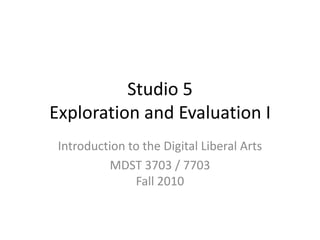
Digital Liberal Arts Exploration and Evaluation
- 1. Studio 5 Exploration and Evaluation I Introduction to the Digital Liberal Arts MDST 3703 / 7703Fall 2010
- 2. Business Quiz 1 due Meetings Mid-term – before or after Fall Break?
- 3. Review Great synthetic posts The story of the Web as open narrative YES Historically connected to Ayers’ topic Railroads, telegraph, etc. and the Internet Common trait of ‘distorting’ social space and time
- 4. Overview Shift gears and move into hands-on criticism Discussion of core principles of design Followed by hands-on exercises focused on specific web sites
- 5. Dan Brown, Angels & Demons, p. 19
- 6. “In March 1989, Tim Berners-Lee submitted a proposal for an information management system to his boss, Mike Sendall. ‘Vague, but exciting’, were the words that Sendall wrote on the proposal, allowing Berners-Lee to continue.” (http://info.cern.ch/Proposal.html)
- 7. Web as Open Narrativeor, the Great Node Theory of History SGML Netscape (Andreeson) Hypertext Microsoft(AJAX) NeXT Google TCP/IP (etc.)
- 9. Scholarship involves … Selection of materials Organization of materials Arguments based on materials that reference them in precise ways Synthesis of Reason + Evidence “Reason” connected to secondary sources – representing, critiquing, modifying, creating arguments Evidence = data and primary sources
- 10. Importance of Structure Mediates between raw data and “cooked” argument Organization of materials is the foundation of scholarship, even if it is not sufficient to define it Scholarship rests on well-ordered collections These provide both access and a view of larger patterns Connects traditional scholarship to digital representation Categories help us define and relate lexia …
- 11. Two Principles of Connection of Lexia in Hypertext Linking Nelson’s concept of link HTML anchor elements, e.g. <a href=“http://somewhere.com”>I am a link</a> Classification Library of Congress subject headings HTML and XML document structure WP Categories, menus, and tags
- 13. HTML
- 14. TEI
- 17. ". . . the tree of nature and logic by the thirteenth-century poet, philosopher, and missionary Ramon Lull. The main trunk supports a version of the tree of Porphyry, which illustrates Aristotle's categories. The ten leaves on the right represent ten types of questions, and the ten leaves on the left are keyed to a system of rotating disks for generating answers. Such diagrams and disks comprise Lull's Ars Magna (Great Art), which was the first attempt to develop mechanical aids to reasoning. It served as an inspiration to the pioneer in symbolic logic, Gottfried Wilhelm Leibniz.“ -- John Sowa, explaining the cover art for Knowledge Representation
- 20. Categories form the armature of thought Armature for a classical pose of a figure holding a lyre. http://en.wikipedia.org/wiki/File:Armature-sculpture.png
- 21. Some Things about Categories They are foundational to thinking, but are often implicit e.g. Syllogisms Often organized hierarchically, but they don’t have to be Based on core metaphors: trees, kinship, the body, etc. Socially and culturally specific They are used to structure information in concrete ways Organization of libraries and books Organization of web sites
- 22. Exercise 1: Extract the Categories in VOS and TDSM Break up into four groups Explore the two web sites and discuss the categories used to organize the material Think of how everything is organized—from content to concepts Create a list of categories Connect the categories by means of a model Each group will have a scribe who will take notes and maintain the list Put your notes in a post with the category 09-23 Studio Exercise 1
- 23. Exercise 2: Prototype a New Site Use the categories you created in Exercise 1 to create a high level, paper prototype of a new web site that would encompass both sites Imagine two or three basic screen shots This new site should make use of the categories to increase the connectedness of the content in the site The prototype does not have to be complete! The idea is think creatively about design Put your notes in a post with the category 09-23 Studio Exercise 2
Hinweis der Redaktion
- Ask Ellie Stanton, Kathryn Corcoran, and Jonathan Guerra